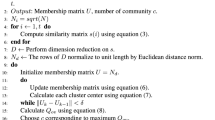Abstract
Recognizing the latent community structure in the multi-relational networks has garnered inexorable attention by the researchers in the recent years. However, detecting overlapping communities in such complex networks is still an open research issue. There are two different types of overlapping possible in the network: crisp and fuzzy. In the network with crisp overlapping community structure, a node fully belongs to one or more communities at the same time. With fuzzy overlapping in the communities, a node can simultaneously belong to multiple clusters with different belonging factors. In this article, we attempt to discover fuzzy overlapping communities in multi-relational networks by combining non-negative matrix factorization, cluster ensemble approach and fuzzy c-means clustering. An extensive experimental study is performed on publicly available Twitter and YouTube datasets. The results obtained are promising and establish the efficacy of our scheme.
Access this chapter
Tax calculation will be finalised at checkout
Purchases are for personal use only
Similar content being viewed by others
References
Chen, W., Liu, Z., Sun, X., Wang, Y.: A game-theoretic framework to identify overlapping communities in social networks. Data Min. Knowl. Disc. 21(2), 224–240 (2010)
Greene, D., Cunningham, P.: Producing a unified graph representation from multiple social network views. ACM Web Sci. 2, 129–233 (2013)
Gregory, S.: Finding overlapping communities in networks by label propagation. New J. Phys. 12(10), 103018 (2010)
Gregory, S.: Fuzzy overlapping communities in networks. J. Stat. Mech: Theory Exp. 2, P02017 (2011)
Gregory, S: A fast algorithm to find overlapping communities in networks. In: Proceedings of Joint European Conference on Machine Learning and Knowledge Discovery in Databases, pp. 408–423 (2008)
Hullermeier, E., Rifqi, M.: A fuzzy variant of the Rand index for comparing clustering structures. In: Proceedings of Joint 2009 International Fuzzy Systems Association World Congress and 2009 European Society of Fuzzy Logic and Technology Conference (2009)
Lee, D.D., Seung, H.S: Algorithms for non-negative matrix factorization. In: Advances in Neural Information Processing Systems, pp. 556–562 (2011)
Mei, J.P., Chen, L.: A fuzzy approach for multitype relational data clustering. IEEE Trans. Fuzzy Syst. 20(2), 358–371 (2012)
Nepusz, T., Petróczi, A., Négyessy, L., Bazsó, F.: Fuzzy communities and the concept of bridgeness in complex networks. Phys. Rev. E 77(1), 016107 (2008)
Palla, G., Derényi, I., Farkas, I., Vicsek, T.: Uncovering the overlapping community structure of complex networks in nature and society. Nature 435(7043), 814–818 (2005)
Papadopoulos, S., Kompatsiaris, Y., Vakali, A., Spyridonos, P.: Community detection in social media. Data Min. Knowl. Disc. 24, 515–554 (2012)
Shen, H.W., Cheng, X.Q., Guo, J.F.: Quantifying and identifying the overlapping community structure in networks. J. Stat. Mech: Theory Exp. 2009(07), P07042 (2009)
Strehl, A., Ghosh, J.: Cluster ensembles—a knowledge reuse framework for combining multiple partitions. J. Mach. Learn. Res. 3, 583–617 (2003)
Tang, L., Wang, X., Liu, H.: Community detection via heterogeneous interaction analysis. Data Min. Knowl. Disc. 25(1), 1–33 (2011)
Wang, X., Jiao, L., Wu, J.: Adjusting from disjoint to overlapping community detection of complex networks. Phys. A Stat. Mech. Appl. 388(24), 5045–5056 (2009)
Wu, Z., Cao, J., Zhu, G., Yin, W., Cuzzocrea, A., Shi, J.: Detecting overlapping communities in poly-relational networks. World Wide Web 18(5), 1373–1390 (2015)
Zhang, S., Wang, R.S., Zhang, X.S.: Identification of overlapping community structure in complex networks using fuzzy c-means clustering. Phys. A Stat. Mech. Appl. 374(1), 483–490 (2007)
Author information
Authors and Affiliations
Corresponding author
Editor information
Editors and Affiliations
Rights and permissions
Copyright information
© 2018 Springer International Publishing AG
About this paper
Cite this paper
Verma, A., Bharadwaj, K.K. (2018). Fuzzy Overlapping Community Detection in Multi-relational Networks. In: Abraham, A., Cherukuri, A., Madureira, A., Muda, A. (eds) Proceedings of the Eighth International Conference on Soft Computing and Pattern Recognition (SoCPaR 2016). SoCPaR 2016. Advances in Intelligent Systems and Computing, vol 614. Springer, Cham. https://doi.org/10.1007/978-3-319-60618-7_64
Download citation
DOI: https://doi.org/10.1007/978-3-319-60618-7_64
Published:
Publisher Name: Springer, Cham
Print ISBN: 978-3-319-60617-0
Online ISBN: 978-3-319-60618-7
eBook Packages: EngineeringEngineering (R0)




